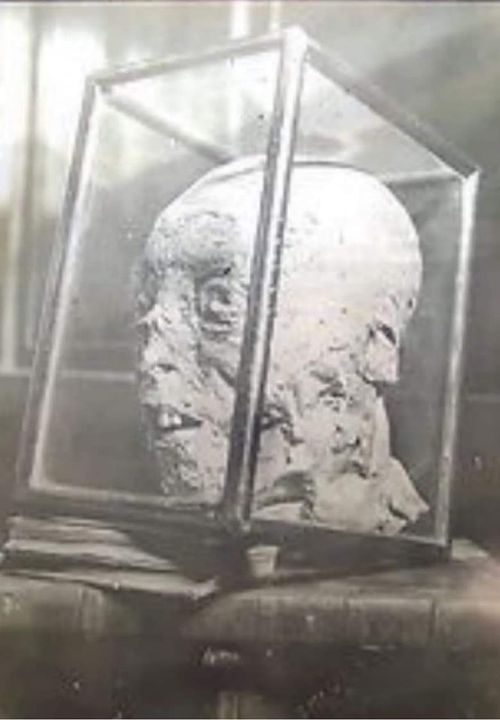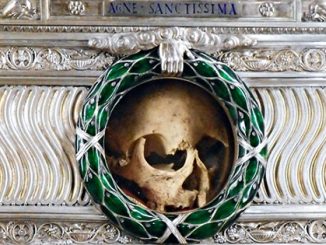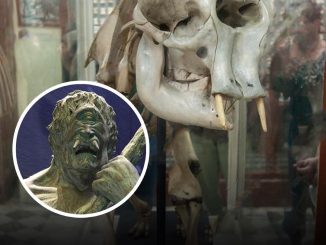The discovery of the mummified head of Henry Grey, the 1st Duke of Suffolk, is a compelling window into the tumultuous period of Tudor England. Unearthed in 1849 at Holy Trinity at the Minories, close to the Tower of London, this grisly artifact was later transferred to St Botolph’s Aldgate. There, it remained until 1990 when an archaeological investigation prompted by a planned office conversion led to its rediscovery. This post explores the fascinating story of Henry Grey, his tragic downfall, and the remarkable journey of his severed head through history. We will also delve into the broader context of ancient discoveries and their impact on our understanding of the past. Be sure to view the accompanying images to gain a deeper appreciation of this historical relic.

The Life and Tragic End of Henry Grey
Henry Grey, born in 1517, was a prominent figure in the court of Tudor England. As the father of Lady Jane Grey, he played a significant role in the political machinations that briefly placed his daughter on the English throne. Jane Grey, known as the “Nine Days’ Queen,” was an unfortunate pawn in the power struggle following the death of Edward VI. Her brief reign ended in tragedy when Mary Tudor, the rightful heir, ascended to the throne and had Jane executed for treason.
Henry Grey’s ambitions and alliances made him a controversial figure. His support for the Protestant cause and his involvement in the plot to install his daughter as queen led to his downfall. After Jane’s execution in 1553, Grey continued to oppose Mary Tudor’s reign. His participation in Thomas Wyatt’s rebellion against the Queen in 1554 sealed his fate. Captured and charged with high treason, Grey was beheaded on February 23, 1554. His execution was a stark reminder of the brutal power struggles of the time.
The Journey of the Mummified Head
The mummified head of Henry Grey was discovered in 1849 during renovations at Holy Trinity at the Minories. This church, located near the Tower of London, was a fitting resting place for a man whose life was so entwined with the fortunes of the Tudor monarchy. The head, remarkably preserved, was later transferred to St Botolph’s Aldgate. For many years, it remained there, largely forgotten, until a planned conversion of the space into an office necessitated an archaeological investigation between April and July 1990.
During this investigation, archaeologists recovered the head from the vault. The Rector of the church, recognizing the historical significance of the find, decided to bury it in the churchyard. This act of reburial symbolized a final resting place for a man whose life had been marked by ambition, intrigue, and tragedy. The discovery and subsequent reburial of Grey’s head offer a poignant connection to the past, reminding us of the human stories behind historical events.
Viewing the Images: A Glimpse into the Past
Images of the mummified head of Henry Grey provide a stark and evocative glimpse into the past. These visual artifacts allow us to connect more intimately with history, bridging the gap between modern times and the turbulent period of the Tudor monarchy. The preservation of the head, with its haunting features, offers a visceral reminder of the brutal realities of 16th-century England.
Viewing these images, one cannot help but reflect on the life and legacy of Henry Grey. His story is not just one of political ambition and tragic downfall but also a testament to the enduring human spirit in the face of adversity. The mummified head, with its preserved features, serves as a powerful symbol of the past, evoking a sense of empathy and understanding for those who lived through such tumultuous times.
Ancient Discoveries: Unlocking the Secrets of History
The rediscovery of Henry Grey’s mummified head is part of a broader narrative of ancient discoveries that continue to shape our understanding of history. Each archaeological find offers new insights into the lives of those who came before us, shedding light on their customs, beliefs, and daily experiences. From the tombs of Egyptian pharaohs to the ruins of ancient civilizations, these discoveries provide invaluable glimpses into the past.
One particularly significant ancient discovery is the Rosetta Stone, which unlocked the secrets of Egyptian hieroglyphs. Discovered in 1799, this artifact allowed scholars to decipher the language of the ancient Egyptians, opening up a wealth of knowledge about their civilization. Similarly, the excavation of Pompeii and Herculaneum has provided detailed insights into Roman life, preserving entire cities frozen in time by the eruption of Mount Vesuvius in 79 AD.
The preservation of Henry Grey’s head, while less grandiose, offers a unique perspective on Tudor England. It underscores the importance of historical artifacts in connecting us to our past and enriching our understanding of human history. Each discovery, whether a grand monument or a humble relic, contributes to the tapestry of our shared heritage.
Conclusion
The mummified head of Henry Grey, 1st Duke of Suffolk, serves as a poignant reminder of the complexities and tragedies of Tudor England. From his ambitious rise to his tragic fall, Grey’s story is a microcosm of the broader struggles for power and survival that characterized the period. The rediscovery of his head and its journey through history highlight the enduring significance of historical artifacts in preserving our past.
As we continue to uncover and study ancient discoveries, we gain a deeper appreciation for the richness and diversity of human history. Each artifact, whether a grand monument or a simple relic, offers valuable insights into the lives of those who came before us. By viewing the images associated with these discoveries, we can connect more intimately with the past, bridging the gap between our modern world and the ancient civilizations that laid the foundations of our shared heritage.
In exploring the myths, legends, and tangible remnants of history, we are reminded of the enduring human quest for knowledge and understanding. The mummified head of Henry Grey, along with other ancient discoveries, serves as a testament to the resilience and ingenuity of the human spirit, inviting us to delve deeper into the stories that shape our world.


